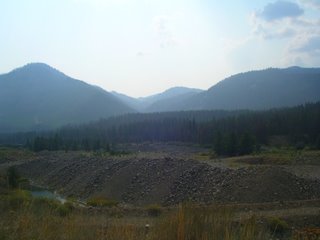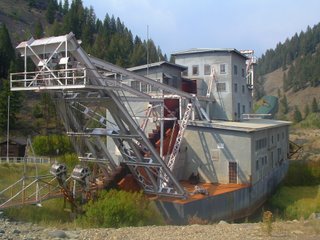 Deep in the Idaho mountains and miles from the paved road, the ghost town of Bonanza City sits along the Yankee Fork of the Salmon River. In 1873, "placer" gold, or tiny flakes that eroded from exposed veins and settled in alluvial sediments of creeks and streams, was discovered in the river. Five years later, 1,500 people lived in the bustling boomtown community of Bonanza City. Today, the only inhabitants are the mountain goats on the craggy hillsides.
Deep in the Idaho mountains and miles from the paved road, the ghost town of Bonanza City sits along the Yankee Fork of the Salmon River. In 1873, "placer" gold, or tiny flakes that eroded from exposed veins and settled in alluvial sediments of creeks and streams, was discovered in the river. Five years later, 1,500 people lived in the bustling boomtown community of Bonanza City. Today, the only inhabitants are the mountain goats on the craggy hillsides. At first, grizzled miners scooped up sand and pebbles from the river in metal pans and aggitated the sediments looking for tiny flakes. As technology improved, more efficient and ecologically destructive methods of placer mining evolved. The panners were replaced by steam shovels that could scoop up entire river bottoms. Powerful hydraulic water cannons blew massive amounts of rock and dirt from the river bank. By the time the claim dried up in the 1930's, the natural hydrology of the Yankee Fork was forever obliterated. The mounds of gravel along the meandering creek bed are scar tissue from a wound that will never heal.
At first, grizzled miners scooped up sand and pebbles from the river in metal pans and aggitated the sediments looking for tiny flakes. As technology improved, more efficient and ecologically destructive methods of placer mining evolved. The panners were replaced by steam shovels that could scoop up entire river bottoms. Powerful hydraulic water cannons blew massive amounts of rock and dirt from the river bank. By the time the claim dried up in the 1930's, the natural hydrology of the Yankee Fork was forever obliterated. The mounds of gravel along the meandering creek bed are scar tissue from a wound that will never heal. By 1938, six million cubic yards of earth had been displaced. At the time, the total value of the gold recovered from the Yankee Fork operation was 11 million dollars- so roughly speaking, fifty cubic feet of river-bottom produced two bucks worth of gold. A gold dredge was built (seen here) to re-process the piles of gravel, extracting an additional 1.2 million dollars worth of gold flakes. Sometimes you can squeeze blood from a turnip. The dredge operation ended in the 1950's and has since been re-built by former employees for visitors to see.
By 1938, six million cubic yards of earth had been displaced. At the time, the total value of the gold recovered from the Yankee Fork operation was 11 million dollars- so roughly speaking, fifty cubic feet of river-bottom produced two bucks worth of gold. A gold dredge was built (seen here) to re-process the piles of gravel, extracting an additional 1.2 million dollars worth of gold flakes. Sometimes you can squeeze blood from a turnip. The dredge operation ended in the 1950's and has since been re-built by former employees for visitors to see. After the gold ran out, after two forest fires burned the area, the residents of Bonanza City moved elsewhere. Like so many of the gold rush towns in the west, most of the equipment was salvaged and removed after the claim ran out, except for the largest and heaviest of items. The ruins of Bonanza, once a city with running water and saloons, is now a cluster of collapsing cabins and rusting ironworks.
After the gold ran out, after two forest fires burned the area, the residents of Bonanza City moved elsewhere. Like so many of the gold rush towns in the west, most of the equipment was salvaged and removed after the claim ran out, except for the largest and heaviest of items. The ruins of Bonanza, once a city with running water and saloons, is now a cluster of collapsing cabins and rusting ironworks. At the nearby Boot Hill cemetary, wooden grave markers (many inscribed with "UNKNOWN") lie scattered among clumps of high sagebrush. Boot Hill cemetaries were named such because the interred usually died penniless and violently (such as a gunfight or a mine accident), and they were buried quickly in a pine box with their boots still on their feet. No one knew who they were or where they came from or asked any questions. After the gold rush ended and the scavengers removed anything and everything of value from Bonanza City, after placer mining destroyed the fishery and riparian habitat, the fading grave markers are one of the few signs there was once life on the Yankee Fork.
At the nearby Boot Hill cemetary, wooden grave markers (many inscribed with "UNKNOWN") lie scattered among clumps of high sagebrush. Boot Hill cemetaries were named such because the interred usually died penniless and violently (such as a gunfight or a mine accident), and they were buried quickly in a pine box with their boots still on their feet. No one knew who they were or where they came from or asked any questions. After the gold rush ended and the scavengers removed anything and everything of value from Bonanza City, after placer mining destroyed the fishery and riparian habitat, the fading grave markers are one of the few signs there was once life on the Yankee Fork.
skip to main |
skip to sidebar
Pithy Banter and Less Than Inspired Photography

